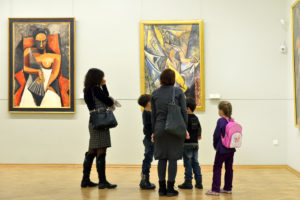A new generation of art connoisseurs is ready for guidance. Art is meant to be appreciated by everyone and can be done as early as possible, even at home. Children are naturally drawn to the creations of others and delight in having their own imaginations captured. It is also a great way to improve visual thinking skills and so much more. Recent studies show art appreciation provides a foundation for growth in math and reading. It also promotes social-emotional advancement and exercises language skills, which grows vocabulary. Try discussing shades and the process of creation to build more sophisticated language – paraphrase what the children say and ask more in-depth questions. Read on for ways to add a little more creativity to your home.

DIY projects
Toddlers can start with color mixing activities. These can be done in a sandwich bag to reduce mess. Grade school children or adults can cut butterfly shapes out of card stock to act as a canvas. Set out primary colors to start. Allow the children to mix red, blue and yellow, which spawn green, purple and orange. Older children or tweens can have fun with a broader range of colors to make pinks, browns and other hues.
Claude Monet, the father of French Impressionism, famously attributed his love of art to flowers. Help children of all ages find their inspiration through nature with a fun and easy project. Gather kid-friendly scissors, construction paper, green paint, a paint brush, markers and a popsicle stick. Start by painting the stick green. Have children draw and cut out a flower. Younger children may benefit from an adult tracing one for them. Glue the flower to the stem. Once done, have the budding artists discuss their creations. Show children how much you value their art by showcasing on the fridge or used in tablescapes for a personal touch.

Selecting from an art gallery
Parents should prepare children for a visit to an art gallery in advance. They should know not to touch the pieces, keep their voices low and nicely express their opinions. Beyond manners, parents can introduce young ones to a variety of mediums to discover which ones will fit in with their home’s style/aesthetic. Photography, sculpture and paintings are the most common. Older children can be involved in discussions on subject matter, abstract versus conceptual art, and placement. If the piece is going to be hung in a child’s room, discuss focal points, colors and subject matter. Keep in mind children will naturally gravitate toward what gives them comfort and joy. If hanging a piece in a common area such as the family room or kitchen, discuss as a family what would best represent the family and the feelings the piece will evoke. If possible, ask the gallery to arrange a meeting with the artist so they can discuss the work and answer questions. Most are open to nurturing future patrons.

Renting pieces
A full commitment to art is not always possible. Many artists are open to renting their pieces for a short duration. This can be done to bring home new art for seasonal, celebratory or personal reasons. Artists with a wealth of original pieces are eligible to sign up for brick and mortar or online rental services. Higher end services assign curators to visit client homes to assess the space, present options and install pieces. This can be done on a three- to six-month rotation. For digital galleries, parents can browse selections as a family or present final options at the dinner table, offering the opportunity for each family member to discuss their preferences, champion their top choices and learn the art of compromise. Bring a love of art home. Children of all ages will benefit from any efforts made to improve their visual learning and language. This article was inspired by the April 1958 edition of Better Homes & Gardens magazine.


